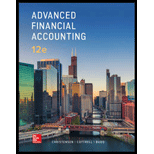
Advanced Financial Accounting
12th Edition
ISBN: 9781259916977
Author: Christensen, Theodore E., COTTRELL, David M., Budd, Cassy
Publisher: Mcgraw-hill Education,
expand_more
expand_more
format_list_bulleted
Concept explainers
Question
Chapter 2, Problem 2.1.3E
To determine
Concept Introduction:
The carrying amount means that the actual value or cost of the underlying asset while mentioned during the purchase. The carrying amount of assets is sometimes different from the value stated by market. Under the Equity method, the carrying amount is updated by the share of company income or losses and it decreases the carrying value by any dividends received on the shares.
The correct option for ascertaining the differentiation between the recording of common stock in investee company between the equity method and the fair value method.
Expert Solution & Answer
Want to see the full answer?
Check out a sample textbook solution
Students have asked these similar questions
How much goes rowerd paying off the principal? Financial accounting
Provide solutions for financial accounting
Transactions:Dec.3Wrote off Langston Corporation’s past-due account as uncollectible, $645.75. M203.
9Accepted a 90-day, 8% note from Farris Company for an extension of time on its account, $2,400.00. NR23.
18Received cash from Storage Solutions for the maturity value of NR19, a 90-day, 9% note for $2,000.00. R455.
21Coastal Supply dishonored NR21, a 90-day, 8% note, for $3,000.00. M245.
30Received cash in full payment of Langston Corporation’s account, previously written off as uncollectible, $645.75. M232 and R463.
Task 1Journalize the transactions for Miller Corporation in Questions Assets that were completed during December of the current year. Use page 12 of the general journal and page 12 of the cash receipts journal.Task 2Post each entry to the general ledger and to the customer accounts in the accounts receivable ledger. You will not need to make entries to the Item columns of the ledgers.Task 3Continue to use page 12 of the general journal. Journalize the December 31…
Chapter 2 Solutions
Advanced Financial Accounting
Ch. 2 - What types of investments in common stock normally...Ch. 2 - Prob. 2.2QCh. 2 - Describe an investor’s treatment of an investment...Ch. 2 - How is the receipt of a dividend recorded under...Ch. 2 - How does carrying securities at fair value...Ch. 2 - Prob. 2.6QCh. 2 - Prob. 2.7QCh. 2 - Prob. 2.8QCh. 2 - Prob. 2.9QCh. 2 - Prob. 2.10Q
Ch. 2 - How are a subsidiary’s dividend declarations...Ch. 2 - Prob. 2.12QCh. 2 - Give a definition of consolidated retained...Ch. 2 - Prob. 2.14QCh. 2 - Prob. 2.15QCh. 2 - Prob. 2.16AQCh. 2 - When is equity method reporting considered...Ch. 2 - How does the fully adjusted equity method differ...Ch. 2 - What is the modified equity method? When might a...Ch. 2 - Choice of Accounting Method Slanted Building...Ch. 2 - Prob. 2.2CCh. 2 - Prob. 2.3CCh. 2 - Prob. 2.4CCh. 2 - Prob. 2.5CCh. 2 - Prob. 2.6CCh. 2 - Prob. 2.1.1ECh. 2 - Multiple-Choice Questions on Accounting for Equity...Ch. 2 - Prob. 2.1.3ECh. 2 - Prob. 2.1.4ECh. 2 - Multiple-Choice Questions on Intercorporate...Ch. 2 - Prob. 2.2.2ECh. 2 - Prob. 2.3.1ECh. 2 - Prob. 2.3.2ECh. 2 - Prob. 2.3.3ECh. 2 - Prob. 2.4ECh. 2 - Acquisition Price Phillips Company bought 40...Ch. 2 - Prob. 2.6ECh. 2 - Prob. 2.7ECh. 2 - Carrying an investment at Fair Value versus Equity...Ch. 2 - Carrying an Investment at Fair Value versus Equity...Ch. 2 - Prob. 2.10ECh. 2 - Prob. 2.11ECh. 2 - Prob. 2.12ECh. 2 - Prob. 2.13ECh. 2 - Income Reporting Grandview Company purchased 40...Ch. 2 - Investee with Preferred Stock Outstanding Reden...Ch. 2 - Prob. 2.16AECh. 2 - Prob. 2.17AECh. 2 - Changes ¡n the Number of Shares Held Idle...Ch. 2 - Investments Carried at Fair Value and Equity...Ch. 2 - Carried at Fair Value Journal Entries Marlow...Ch. 2 - Consolidated Worksheet at End of the First Year of...Ch. 2 - Consolidated Worksheet at End of the Second Year...Ch. 2 - Prob. 2.23PCh. 2 - Prob. 2.24PCh. 2 - Prob. 2.25APCh. 2 - Equity-Method income Statement Wealthy...Ch. 2 - Prob. 2.27BPCh. 2 - Prob. 2.28BP
Knowledge Booster
Learn more about
Need a deep-dive on the concept behind this application? Look no further. Learn more about this topic, accounting and related others by exploring similar questions and additional content below.Similar questions
- Nonearrow_forwardA copy machine cost $95,000 when new and has accumulated depreciation of $83,000. Suppose Pinnacle Office Supplies sold the machine for $14,000. What is the result of this disposal transaction? A. No gain or loss B. Gain of $2,000 C. Loss of $1,000 D. Loss of $44,000arrow_forwardTOSHIBA ended the year with an inventory of $842,000. During the year, the firm purchased $5,467,000 of new inventory and the cost of goods sold reported on the income statement was $5,215,000. What was TOSHIBA's inventory at the beginning of the year? HELParrow_forward
arrow_back_ios
SEE MORE QUESTIONS
arrow_forward_ios
Recommended textbooks for you
 Intermediate Accounting: Reporting And AnalysisAccountingISBN:9781337788281Author:James M. Wahlen, Jefferson P. Jones, Donald PagachPublisher:Cengage Learning
Intermediate Accounting: Reporting And AnalysisAccountingISBN:9781337788281Author:James M. Wahlen, Jefferson P. Jones, Donald PagachPublisher:Cengage Learning Cornerstones of Financial AccountingAccountingISBN:9781337690881Author:Jay Rich, Jeff JonesPublisher:Cengage Learning
Cornerstones of Financial AccountingAccountingISBN:9781337690881Author:Jay Rich, Jeff JonesPublisher:Cengage Learning Financial Reporting, Financial Statement Analysis...FinanceISBN:9781285190907Author:James M. Wahlen, Stephen P. Baginski, Mark BradshawPublisher:Cengage Learning
Financial Reporting, Financial Statement Analysis...FinanceISBN:9781285190907Author:James M. Wahlen, Stephen P. Baginski, Mark BradshawPublisher:Cengage Learning Financial AccountingAccountingISBN:9781337272124Author:Carl Warren, James M. Reeve, Jonathan DuchacPublisher:Cengage Learning
Financial AccountingAccountingISBN:9781337272124Author:Carl Warren, James M. Reeve, Jonathan DuchacPublisher:Cengage Learning

Intermediate Accounting: Reporting And Analysis
Accounting
ISBN:9781337788281
Author:James M. Wahlen, Jefferson P. Jones, Donald Pagach
Publisher:Cengage Learning

Cornerstones of Financial Accounting
Accounting
ISBN:9781337690881
Author:Jay Rich, Jeff Jones
Publisher:Cengage Learning

Financial Reporting, Financial Statement Analysis...
Finance
ISBN:9781285190907
Author:James M. Wahlen, Stephen P. Baginski, Mark Bradshaw
Publisher:Cengage Learning

Financial Accounting
Accounting
ISBN:9781337272124
Author:Carl Warren, James M. Reeve, Jonathan Duchac
Publisher:Cengage Learning